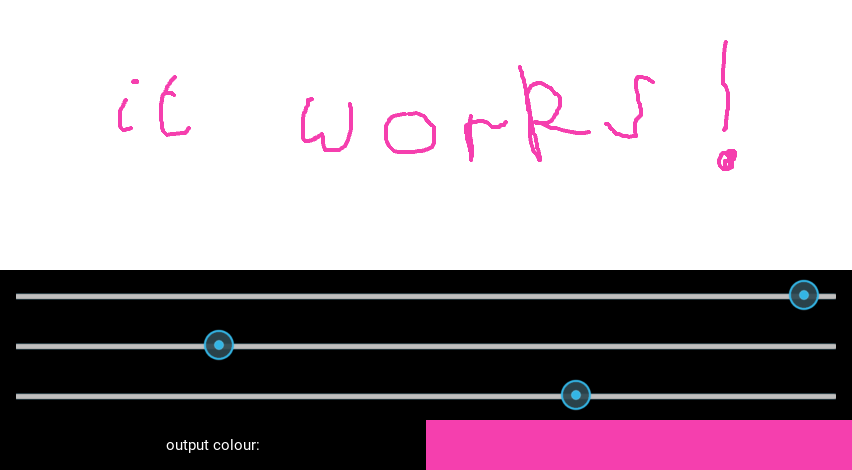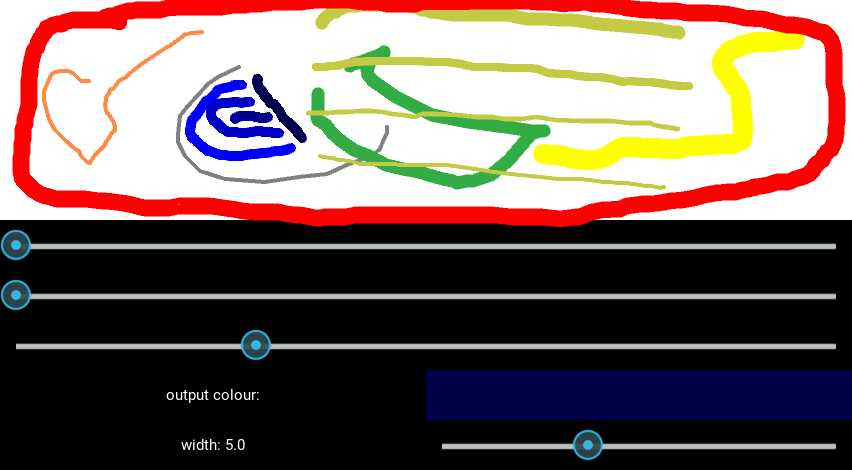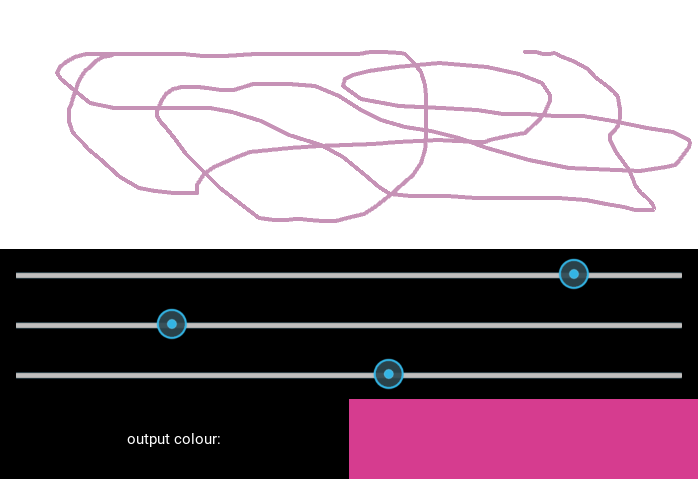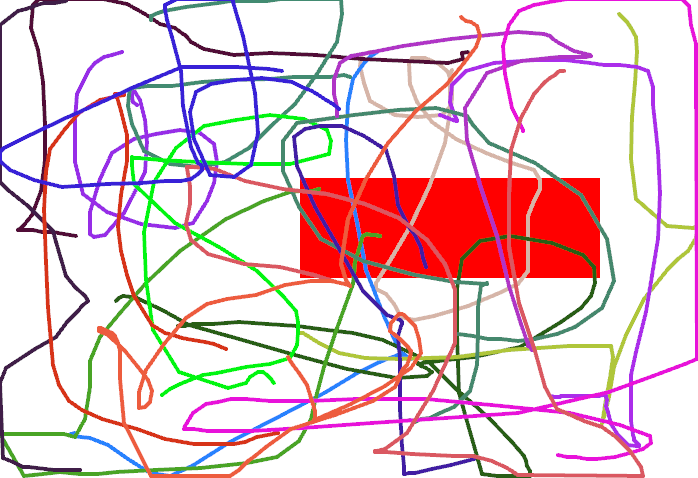This is number 7 in a series of introductory Kivy tutorials.
Central themes: kv language, building a gui, integration with Python
The goal of this tutorial will be to build up a simple gui around the
DrawingWidget built in the last two tutorials. A nice simple goal
would be to let the user select the colour of the lines. Kivy actually
has a ColorPicker Widget for this purpose (see the documentation), but we’ll
skip that for now in order to continue demonstrating Kivy widget construction.
Note: Since all Kivy widgets are built out of other Widgets and
canvas instructions, you might like to think about how you’d build the
ColorPicker from scratch.
Let’s start with the code from last time, minus the now-unnecessary
red Rectangle:
from kivy.app import App
from kivy.uix.boxlayout import BoxLayout
from kivy.uix.slider import Slider
from kivy.uix.widget import Widget
from kivy.graphics import Rectangle, Color, Line
from random import random
class DrawingWidget(Widget):
def __init__(self):
super(DrawingWidget, self).__init__()
with self.canvas:
Color(1, 1, 1, 1)
self.rect = Rectangle(size=self.size,
pos=self.pos)
self.bind(pos=self.update_rectangle,
size=self.update_rectangle)
def update_rectangle(self, instance, value):
self.rect.pos = self.pos
self.rect.size = self.size
def on_touch_down(self, touch):
super(DrawingWidget, self).on_touch_down(touch)
with self.canvas:
Color(random(), random(), random())
self.line = Line(points=[touch.pos[0], touch.pos[1]], width=2)
def on_touch_move(self, touch):
self.line.points = self.line.points + [touch.pos[0], touch.pos[1]]
class DrawingApp(App):
def build(self):
root_widget = DrawingWidget()
return root_widget
DrawingApp().run()
I’ll demonstrate adding the new gui components in two ways; first in
pure Python as has been demonstrated in previous tutorials, and second
using kv language instead. So, here’s a Python implementation of the
new features we want, beginning with importing the Widget classes
we’ll need:
from kivy.uix.boxlayout import BoxLayout
from kivy.uix.label import Label
from kivy.uix.slider import Slider
Slider is a previously-unseen Widget displaying a draggable marker. We’ll be using a
Slider for each primary colour (red, blue, green), and using this to
set the Color when a Line is drawn.
We can now update the build method of DrawingApp, replacing the root
widget and adding the new gui components:
class DrawingApp(App):
def build(self):
root_widget = BoxLayout(orientation='vertical')
drawing_widget = DrawingWidget()
red_slider = Slider(min=0, max=1, value=0.5,
size_hint_y=None, height=50)
green_slider = Slider(min=0, max=1, value=0.5,
size_hint_y=None, height=50)
blue_slider = Slider(min=0, max=1, value=0.5,
size_hint_y=None, height=50)
colour_row = BoxLayout(orientation='horizontal',
size_hint_y=None, height=50)
colour_label = Label(text='output colour:')
colour_widget = Widget()
# We draw a Rectangle on colour_widget exactly the same way as
# with DrawingWidget, just without making a new class
with colour_widget.canvas:
output_colour = Color(red_slider.value,
green_slider.value,
blue_slider.value)
output_rectangle = Rectangle()
def update_colour_widget_rect(instance, value):
output_rectangle.pos = colour_widget.pos
output_rectangle.size = colour_widget.size
colour_widget.bind(pos=update_colour_widget_rect,
size=update_colour_widget_rect)
def update_colour_widget_colour(instance, value):
output_colour.rgb = (red_slider.value,
green_slider.value,
blue_slider.value)
red_slider.bind(value=update_colour_widget_colour)
green_slider.bind(value=update_colour_widget_colour)
blue_slider.bind(value=update_colour_widget_colour)
root_widget.add_widget(drawing_widget)
root_widget.add_widget(red_slider)
root_widget.add_widget(green_slider)
root_widget.add_widget(blue_slider)
root_widget.add_widget(colour_row)
colour_row.add_widget(colour_label)
colour_row.add_widget(colour_widget)
return root_widget
This is a lot of code to drop all at once, but read it carefully and
you’ll see that it’s only the same concepts already introduced: we
instantiate Widgets, add them to one another, and create bindings so
that things automatically happen when Kivy properties are changed. In
this case, we make use of the value Kivy property of the
Slider widget, which gives its current value (changing automatically
when the slider is moved).
Run the code and you should see something like the image below. You
can update the colour in the bottom right by moving the sliders.
A problem now becoming obvious is that all this code is kind of
verbose, and also it can be a little unclear what is happening -
Widget instantiation is in a different place to where the Widgets are
added to one another, which is different again to where their events
are bound. You can mitigate this with a careful app structure and
following whatever coding conventions you like, but some of it is
unavoidable given how Python works.
It’s for this reason that Kivy comes with kv language, a simple but
powerful declaration language specifically designed for creating Kivy
widget trees. If learning a new language sounds worrying…don’t be
concerned! Kv isn’t a general purpose language, it doesn’t have much
special syntax and is targeted specifically at Kivy widgets. It also
uses normal Python code wherever possible (we’ll see that soon).
All of the kv language stuff discussed below is documented on the
Kivy website; I’ll cover
the basics, but you can find more information there.
First, get rid of all the Python code from above, and replace the
root widget return with the following:
class Interface(BoxLayout):
pass
class DrawingApp(App):
def build(self):
root_widget = Interface()
return root_widget
Kv language works by writing rules for Widget classes, which will be
automatically applied every time you instantiate one. We can use kv
for almost everything added to the app so far, but this time we’ll
construct the gui step by step to see how each part is added with the
new kv syntax. We’ll be writing a kv rule for the new
Interface class.
To start using kv language, write the following code in a file named
drawing.kv. This name comes from the name
of the App class, minus the App at the end if present, and in
lowercase (e.g. if you named your App MySuperKivyApp you’d
need to name the file mysuperkivy.kv). This is only necessary if
you want the file to be automatically loaded, you can also load files
or string manually. Our first
kv code is:
<Interface>:
orientation: 'vertical'
Label:
text: 'label added with kv'
font_size: 50
Run the code again, and you should see the a Label with the given
text, as the kv file is automatically loaded and its
<Interface> rule applied.
This demonstrates the core rules of kv syntax. A kv rule is created
with the <WidgetName>: syntax. You can make a rule for any
widget, including built in ones (Kivy internally has a large kv file), and
if you make multiple rules for the same Widget then all of them are
applied one by one.
Below the rule creation, we indent by 4 spaces and define values for
Kivy properties of the widget, and add child widgets. Lines like
orientation: 'vertical' set Kivy properties just like we did
previously in the Python code. Note that everything to the right of
the colon is normal Python code - that doesn’t matter here, but for
instance we could equally well write orientation: ''.join(['v',
'e', 'r', 't', 'i', 'c', 'a', 'l']) and it would be exactly the
same. You can set any Kivy property of a widget in this way, finding
the available options in the documentation as previously discussed.
We can also add child widgets by writing the widget name with a colon,
then indenting by a further 4 spaces, as is done here with the
Label. After this you can keep going as deep as you like,
setting properties or adding more child widgets.
We can use these pieces of syntax to construct the previous Python
interface entirely in kv:
<Interface>:
orientation: 'vertical'
DrawingWidget:
Slider:
min: 0
max: 1
value: 0.5
size_hint_y: None
height: 50
Slider:
min: 0
max: 1
value: 0.5
size_hint_y: None
height: 50
Slider:
min: 0
max: 1
value: 0.5
size_hint_y: None
height: 50
BoxLayout:
orientation: 'horizontal'
size_hint_y: None
height: 50
Label:
text: 'output colour:'
Widget:
This hasn’t yet set up the event binding, but the full widget tree has
been constructed entirely using the kv syntax described above. The
immediate advantage of this is that kv language directly expresses the
widget tree - there are no longer separate steps for instantiating
Widgets, setting their properties and adding them to one
another. Instead, you get to see everything at once.
This gui doesn’t yet have the behaviour of the Python one (i.e. having
the sliders control output colour), but in the interest of keeping
these tutorials relatively short, I’ll stop here for now. In the next
tutorial will see how kv language also makes event binding very easy.
Next tutorial: More kv language
Full code
main.py:
from kivy.app import App
from kivy.uix.boxlayout import BoxLayout
from kivy.uix.slider import Slider
from kivy.uix.boxlayout import BoxLayout
from kivy.uix.label import Label
from kivy.uix.slider import Slider
from kivy.uix.widget import Widget
from kivy.graphics import Rectangle, Color, Line
from random import random
class DrawingWidget(Widget):
def __init__(self):
super(DrawingWidget, self).__init__()
with self.canvas:
Color(1, 1, 1, 1)
self.rect = Rectangle(size=self.size,
pos=self.pos)
self.bind(pos=self.update_rectangle,
size=self.update_rectangle)
def update_rectangle(self, instance, value):
self.rect.pos = self.pos
self.rect.size = self.size
def on_touch_down(self, touch):
super(DrawingWidget, self).on_touch_down(touch)
if not self.collide_point(*touch.pos):
return
with self.canvas:
Color(random(), random(), random())
self.line = Line(points=[touch.pos[0], touch.pos[1]], width=2)
def on_touch_move(self, touch):
if not self.collide_point(*touch.pos):
return
self.line.points = self.line.points + [touch.pos[0], touch.pos[1]]
class Interface(BoxLayout):
pass
class DrawingApp(App):
def build(self):
root_widget = Interface()
return root_widget
DrawingApp().run()
drawing.kv:
<Interface>:
orientation: 'vertical'
DrawingWidget:
Slider:
min: 0
max: 1
value: 0.5
size_hint_y: None
height: 50
Slider:
min: 0
max: 1
value: 0.5
size_hint_y: None
height: 50
Slider:
min: 0
max: 1
value: 0.5
size_hint_y: None
height: 50
BoxLayout:
orientation: 'horizontal'
size_hint_y: None
height: 50
Label:
text: 'output colour:'
Widget:





